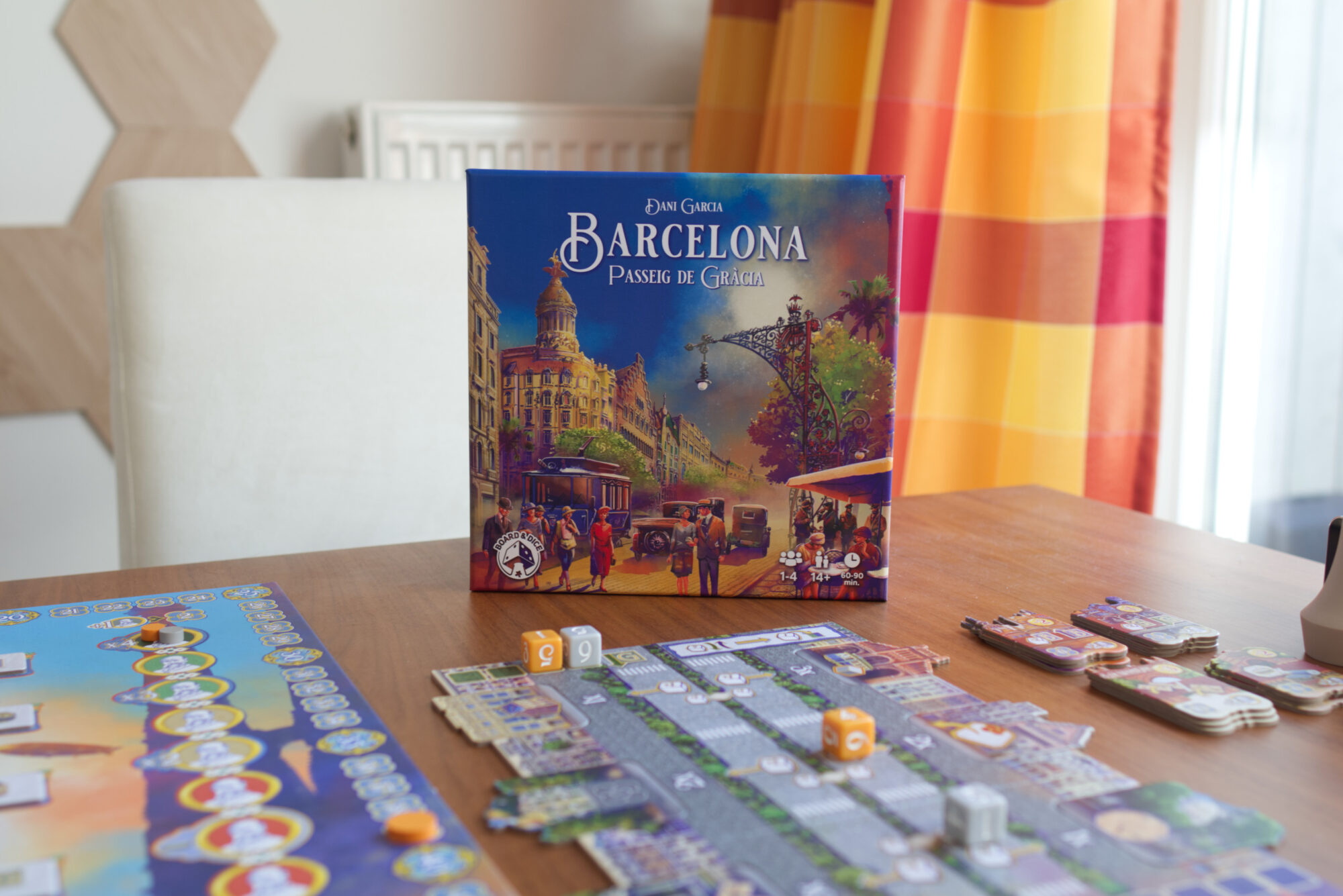Aaah, Barcelona! It’s been many, many years since I’ve been in this beautiful city, but I still have fond memories of it: Sitting in the Parc Güell, visiting the brilliant Gaudi museum inside La Pedrera, or in general strolling through the city and being amazed by its architecture. All those beautiful moorish-inspired private gardens on the inside of houses, the incredible facades, and don’t even get me started on the awesome food! I don’t travel much and I rarely visit the same location twice because I like exploring new places, but if there’s one place I’d put on my must-go-again list, it would be Barcelona.
Similar to the city it is named after, Barcelona the board game has lodged itself firmly in my brain. It had a unique action selection mechanism where one chooses an intersection both for the combination of two or three actions to perform as well as to be able to build a new building – and ideally prevent opponents from being able to do so themselves. It had tons of charm, almost as much as it had an abundance of victory points. Designer Dani Garcia apparently likes his combos as the game came with whopping 400VP markers in case players manag to go four times around the scoring track! So far, my record is somewhere in the 350s, but even that number is unheard of for most modern Euros.
I had a great time with Barcelona, but as a reviewer, there sadly are always other games vying for table time. As a result, I haven’t played Barcelona all that much since I wrote my original review. Whenever someone suggested it though, it was always to the same result: good times were had by all. So I had been looking forward to Barcelona’s expansion ever since I first heard of it and now the time has finally come. Let’s see what it has in stock for us …
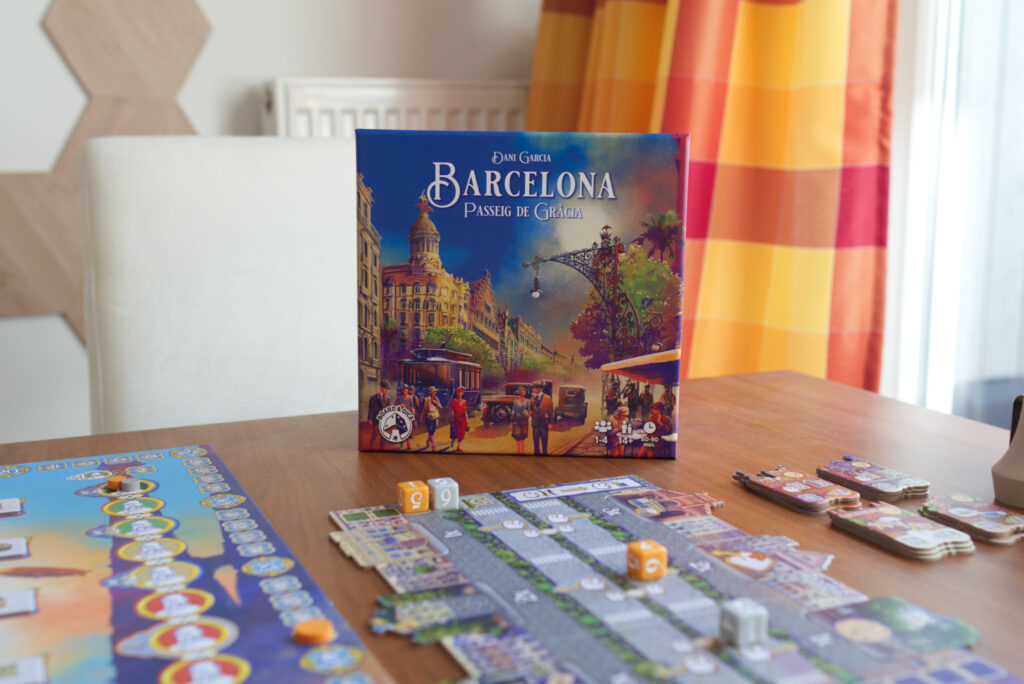
Setup
Barcelona: Passeig de Gràcia comes in a small but beautifully illustrated box that I got for around 20€, which is already a good start. And before someone asks: yes, one can easily dump all the expansion content into the base box. I wonder when did “does it all fit in the box?” become the primary question on people’s minds when talking about expansions, but let’s not get on a tangent here.
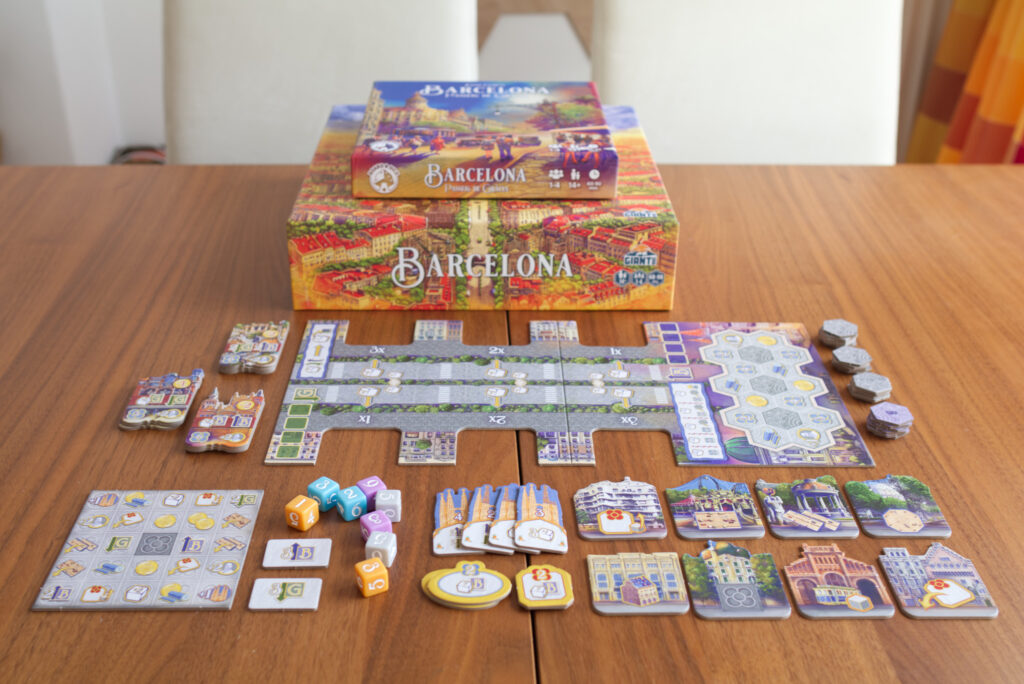
All the components are in service of a new core action: moving pedestrians on the iconic Passeig de Gràcia. Before we come to that, let’s get setup out of the way. There is an overlay for the cobblestone placement rewards that includes the new “move pedestrian” action which is symbolised by an arrow and letter to indicate if the pedestrian on the road to Barcelona or the other one on the road to Gràcia is to be moved. There is also a symbol of a generic white die with a positive value which obviously allows increasing a die’s value by rotating it.
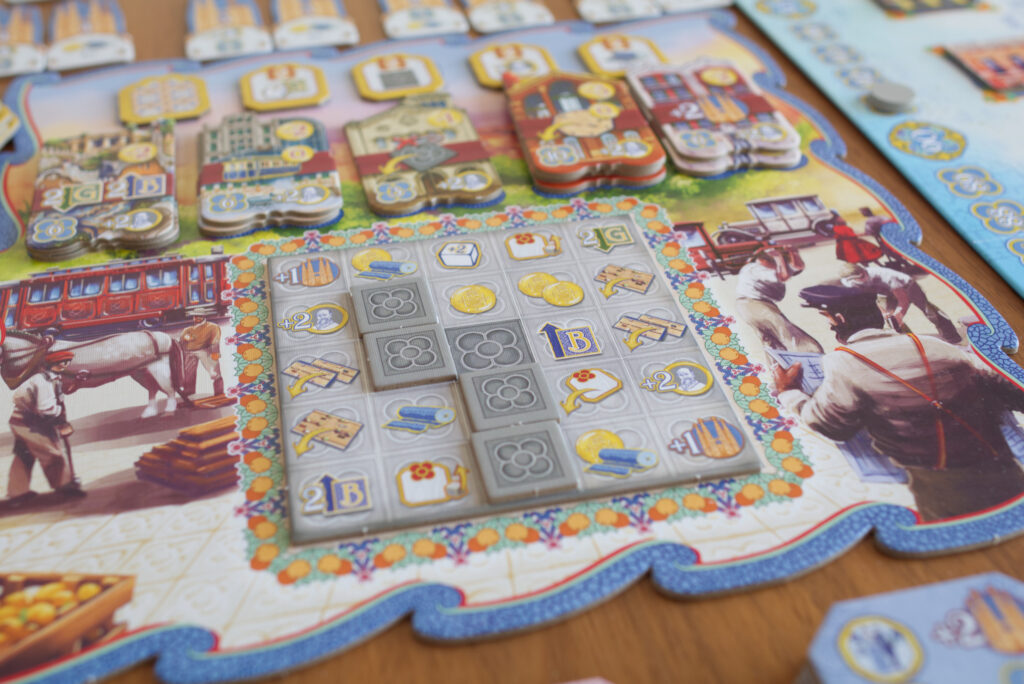
In a similar fashion, there are new mandatory action tiles that replace the three typically least frequently used actions of the base game (taking 2 coins, taking a cloth and 3VP, gaining 2 Cerda steps) with movement for pedestrians and a combined gold+cloth action. In a similar fashion, new modernism tiles, Cerda scoring tiles, and Sagrada tiles have been added so that the new pedestrian move action feels as tightly integrated into the system as the original actions were.
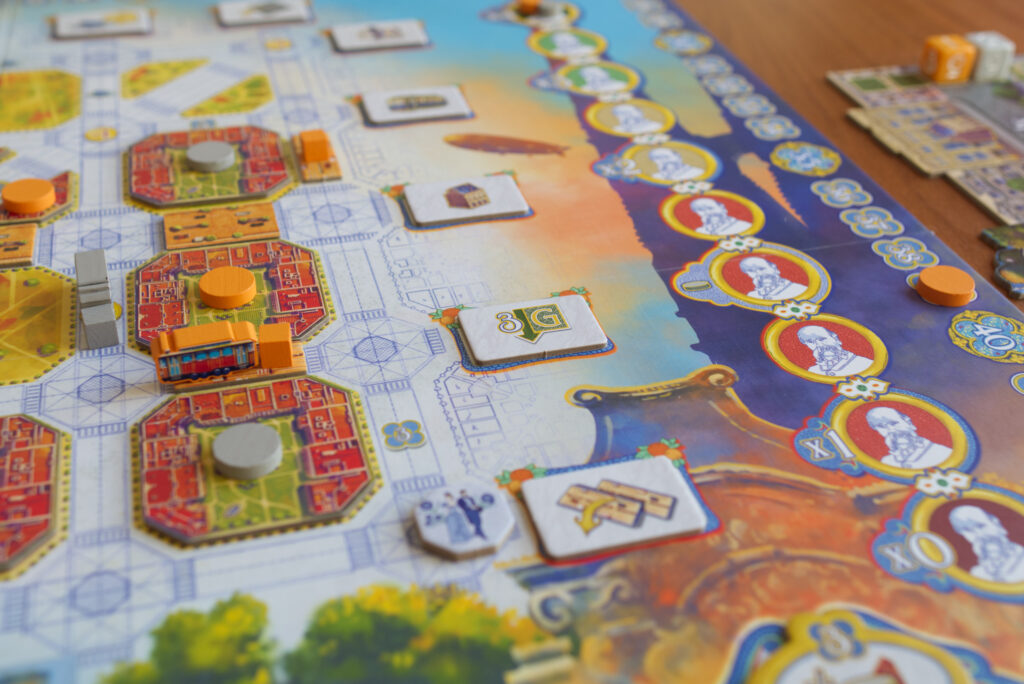
Happy Pedestrians Are Good Pedestrians
The actual Passeig de Gràcia side board is set up by slotting in 6 out of 8 random famous landmarks that show different elements we are already familiar with from the base game: cobblestones, public service buildings, tram passengers, streets, etc. Each player then places two – quite beautiful – dice, one on each end of the two streets towards Barcelona and towards Gràcia. Both initially show a value of one which represents the pedestrians happiness. Whenever a pedestrian is moved using the new move pedestrian action, it checks for each step it takes if the player fulfils the indicated requirement. The first step requires one-of-something, the next two, and the final three (e.g. have you build 1x public service buildings, picked up 2x modernism tiles). If so, the die’s value is incremented by one. Another way how a pedestrian’s happiness can go up is by what we came to call “high fiving”: if both a player’s dice are on the same segment, a little handshake icon indicates that both of them get a +1. This does not work however if one of them is still on its starting position.
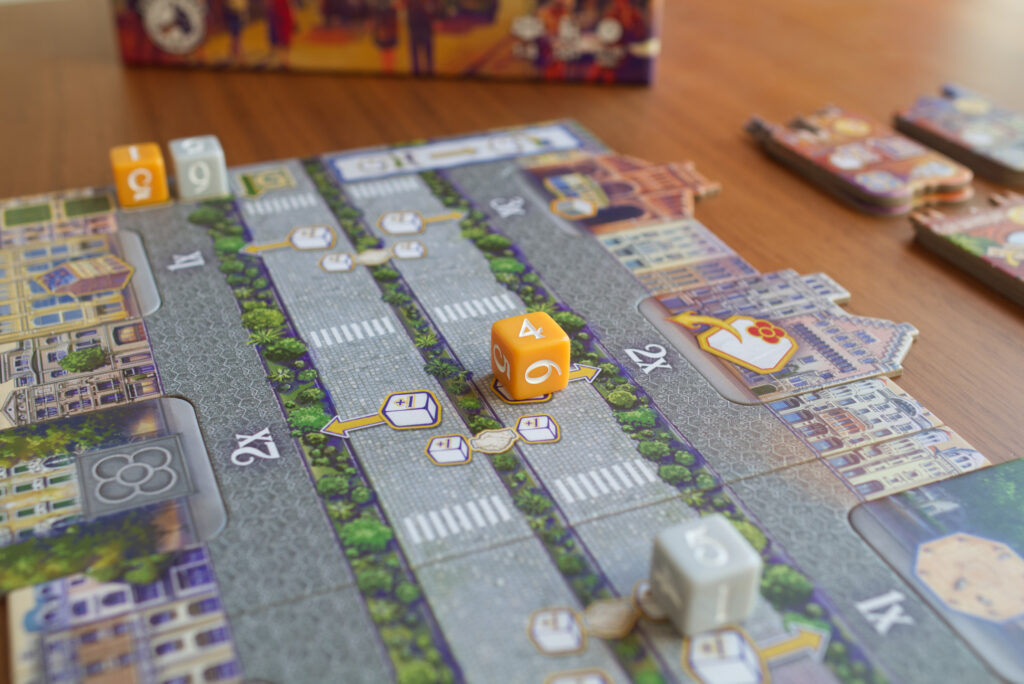
Once a pedestrian reaches the end of its road, the player gets a reward based on the pedestrian’s happiness: 1-3 only awards some measly VP, 4-5 allows placing a new hex-shaped cobblestone (more on that in a sec), and a 6 results in a whopping 15 VP plus a hex-shaped cobblestone plus a free resource! Getting there takes some effort though, even ignoring the actions spent on moving the pedestrian in the first place. If a player manages to fulfil all requirements along the road, that only adds up to a happiness of 4. If one times it right and both pedestrians meet, that can bump it up to five. To get to six, one will either have to snatch a bonus somewhere that adds to the die’s value or time it so the pedestrians meet twice. This can happen because once one pedestrian is scored, it is reset to a 1 and teleported back to the start of its street. Feels a bit sisyphusian to not turn around and walk the other way back but hey, we’re talking Euros here.
So let’s take a look at the new hex-shaped cobblestones and what those give you. At one end of the Passeig de Gràcia board, three out of six purple hex tiles are placed during setup. These act as multipliers for the surrounding bonus hex fields. If a player’s pedestrians reaches the end of the street with a happiness of four or higher, the player gets to cover one of the yet empty spots and multiply the reward with one of the things shown on the purple hex. In the image shown below, if a player has three Sagrada pieces already, they could place it for either 3x2VP, 3 coins, 3 Cerda steps, etc. In my very first game, I actually managed to get 16 VP this way because there was a 4VP hex with a Cerda track multiplier next to it and I had managed to go all the way up on the Cerda track.
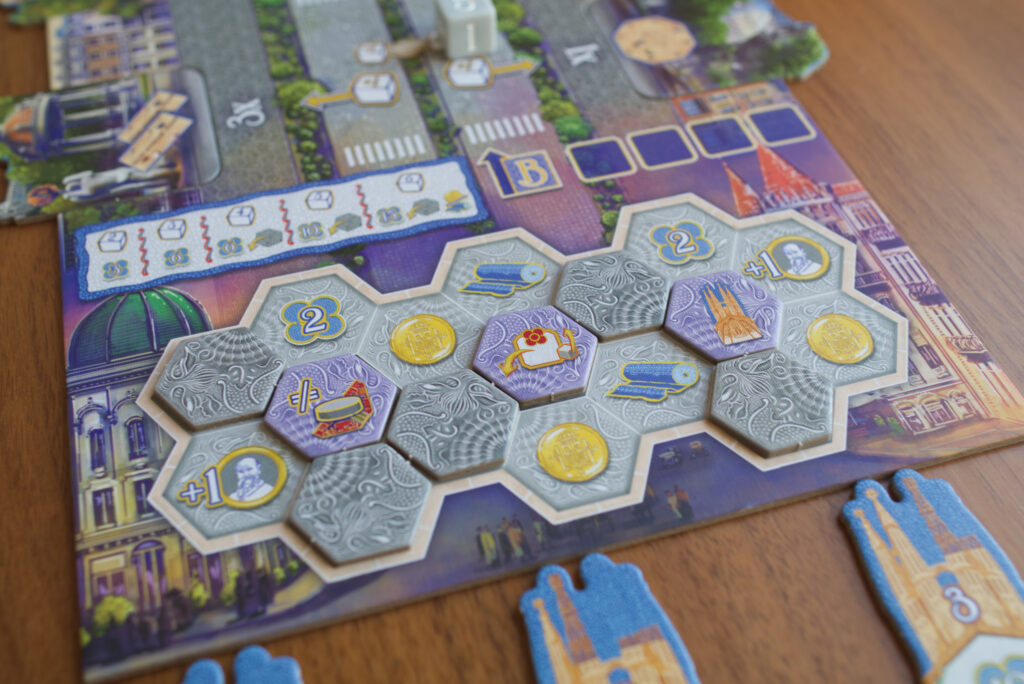
Note: the new hex-shaped cobblestones come from a common supply and unlike the square cobblestones don’t interact with the player’s own board nor provide endgame scoring.
Solo Mode
The solo mode for Passeig de Gràcia is basically the same as for the base game and there are no new automa cards or any other solo-specific component. Whenever the automa reveals a card that shows an action that is featured on an amenity, it moves the pedestrian on that road. If it places the regular cobblestones, it goes for pedestrian movement bonuses as top priority. If one of its pedestrians reaches the end of the street, it always gains the reward for 5 points of happiness and ignores the amenities on the way completely. And when it places a hex-shaped cobblestone, it covers the 4VP spaces first. That’s pretty much it.
And it works. From my plays so far, I would say the automa is on roughly the same level as it was in the base game, meaning I can handily beat it on hard by now (note: there were some small changes to the automa published post-release but I usually don’t play with them as I found they did little to the end result). The expansion would have been a good opportunity to add some more tweaks to the automa to for example have it more smartly choose which intersections to place citizens on, but alas, it just adds behaviour to incorporate the new actions – I assume in an attempt to keep admin time low. One thing I would have wished for is some form of reminder to advance pedestrians if the appropriate action is revealed and a reminder for the new priority of square-shaped cobblestone placement. Quite a number of times, I forgot to advance the automa’s pedestrian and only later was able to reconstruct it. But overall, it’s not a big issue and by now I’m familiar enough with the new rules to not forget them anymore.
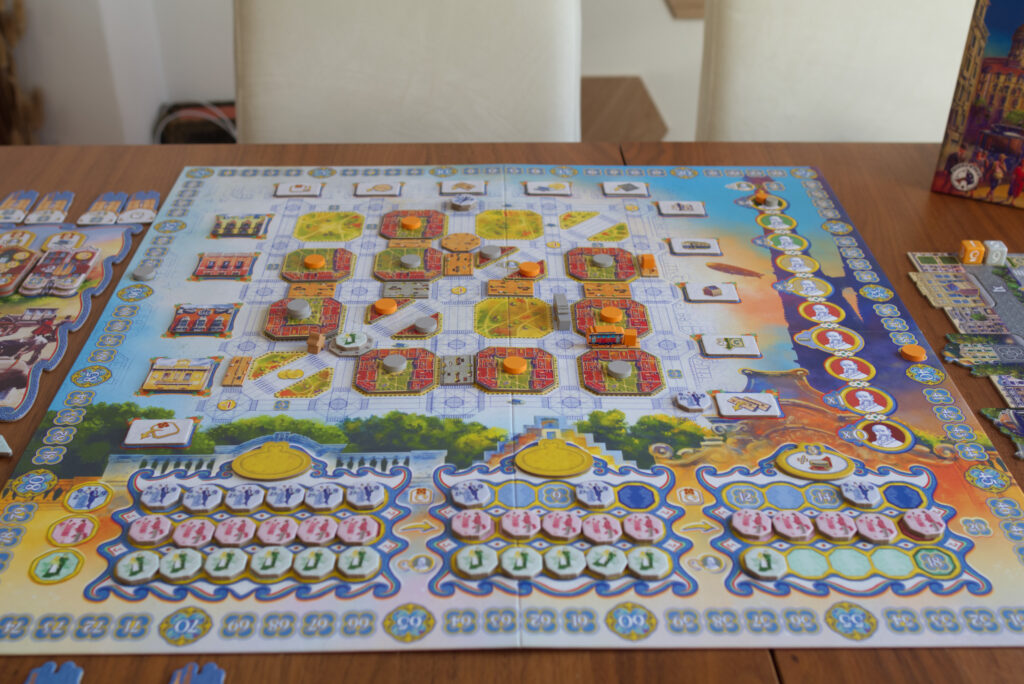
Conclusion
I’m only a couple of plays in and mostly solo, but already some implications from the new mechanism have emerged. First of all: it’s fun. I don’t know how Dani Garcia and Board & Dice do it, but from the beautiful designed dice to how familiar the amenities are to anybody that has visited Barcelona to the gorgeous art, this expansion just put me in a good mood. It also doesn’t add much to setup time and it’s rather easy to explain the new mechanism to anybody that is already familiar with Barcelona.
The new actions have been integrated quite tightly and players will inevitably move along the streets, both because it feels attractive to do so and because otherwise two whole rows/columns of actions will be useless (those that now show the move B/G 3 steps actions). I actually once tried to play without moving pedestrians and focusing on other elements, but it just doesn’t make any sense. The board fills up too quickly with citizens to block the few interesting intersections that don’t involve movement and jumping all over the map to avoid the movement row/column will cause you to not be able to build a building at the end of your turn, losing you VPs and Cerda steps.
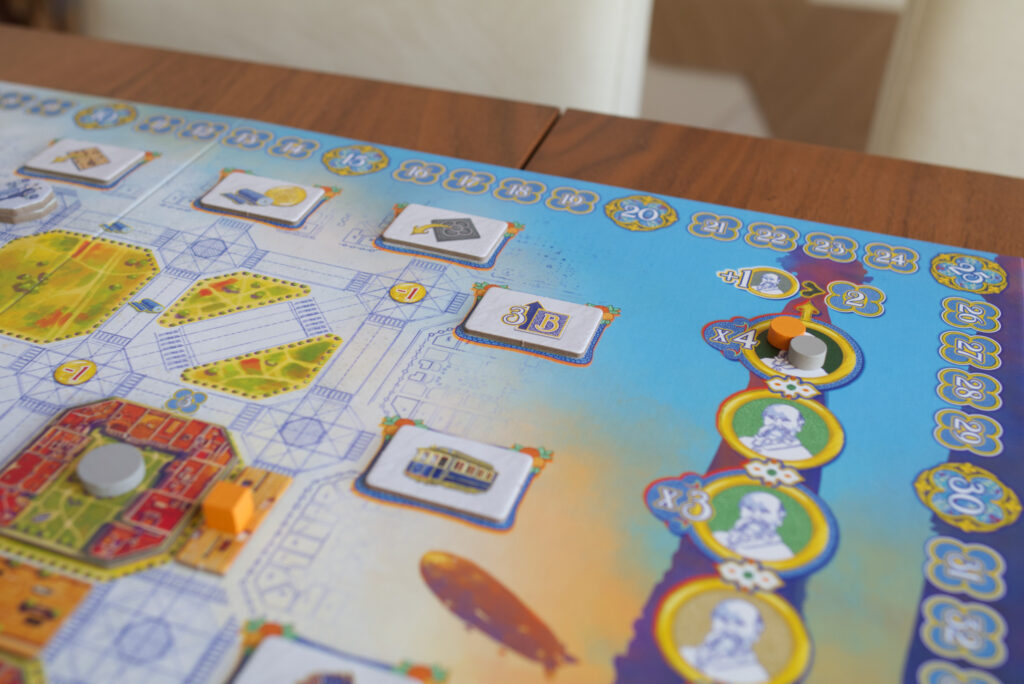
Scoring VP and bonuses via the Passeig de Gràcia feels quite powerful, but luckily not to an amount that it overshadows everything else. One still has to make sure one can construct buildings, score well on the Cerda scorings, build streets for gaining resources, etc. As before, timing is everything and players need to optimise their order of actions to gain small advantages here and there to compound into a big lead in the end.
Having the variable criteria on the Passeig de Gràcia adds a nice incentive to branch out a bit more than in plays of the base game. For example, I still maintain that intersections are underpowered in the base game but if the Passeig de Gràcia now requires to have 2x intersections build to give my pedestrian more happiness, I might actually consider it. In general, the amenities give players orientation, something to aim for. It usually makes sense to focus on one of the two directions, optimise for those amenities. And of course one wants to quickly fulfil the 1x criteria so the very first movement step isn’t already wasted. If the first step for example requires a tram passenger to be placed on the board, you won’t believe how quickly people will try to find some way to do that action in their first 1-2 turns.
My favourite part of the expansion though is this mechanism of making both pedestrians happier when they meet. I don’t know why, but I just love everything about it. It’s cute, it’s evocative, and when you manage to make it happen, you’ll feel clever somehow. I often found myself changing the order of my actions in some minor way so I could move on pedestrian just a little bit so the other later on had time to meet it again and turn into a 6 happiness. Being able to get 15 VP plus a hex-cobblestone (and its rewards) plus a free resource just feels like Christmas in a game where sometimes getting that one more coin is already a struggle.

Having the new hex-shaped cobblestones adds another wrinkle to the game. Suddenly, it’s possible to get three or four coins with a single move action, enabling players to be able to build even the most expansion public service buildings. Or as happened in one of my plays, suddenly get multiple pieces of cloth just in time for a Cerda scoring that rewards having many of them in storage. In general, it felt like I had to pay more attention to what my opponents were doing or rather what they were able to pull off in their next turn.
Adding a new combo-inducing mechanism of course comes with the danger of slowing down gameplay. In reality though, I didn’t find that to be a problem here. The natural restriction of possible actions if one wants to build a building at the end of the turn still keeps options to a manageable amount. One can still sometimes go into a loop of figuring out the best combo and in the end forgetting what one originally wanted to do with it, but that would happen with the base game as well.
Overall, this expansion just feels very much like Barcelona: it’s pleasant, it’s charming, it’s good. Passeig de Gràcia is not a major improvement on the base game (like the recently released Anno 1800 expansion) because there wasn’t anything really broken with the base game in the first place. It’s not introducing anything completely out of the ordinary because that would have made Barcelona overly complex. Instead, it adds to the already existing charm by adding further recognisable sites and extends the possibilities for combos by replacing the three most boring actions. Would I have liked something that utilised the existing map more and strengthens the spacial puzzle? Sure. Like special buildings that have effects on neighbouring blocks or something that restricts where citizens can be placed. But that would probably have turned Barcelona into a very different game and I’m not sure that would have been a good thing.
So I won’t call Passeig de Gràcia a must buy, mainly because Barcelona already worked that well without it. I’d rather dub this a “why shouldn’t you?” expansions. If you liked Barcelona, I can’t think of a single reason why you shouldn’t get this. It’s cheap, fun, doesn’t overcomplicate things, and adds to the proven formula. I’ll always will play with it from now on and I think so should you.
